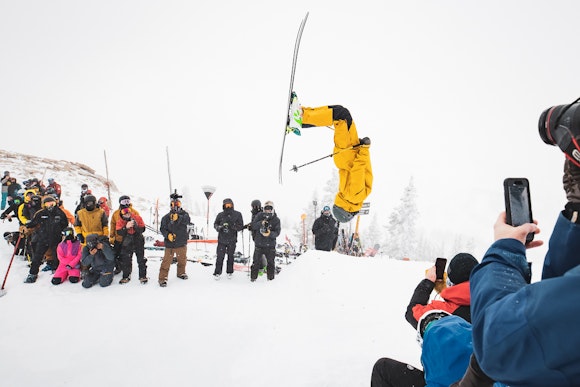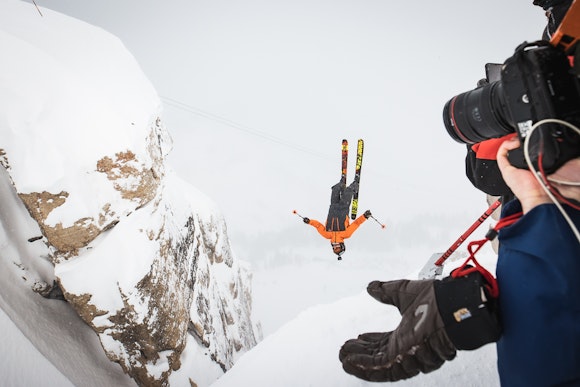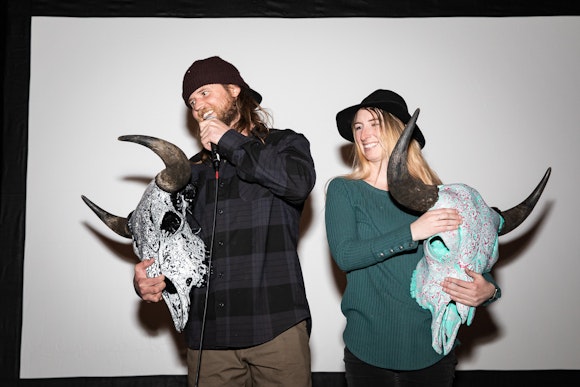At 8:44 am on February 18th, 2021, the early tram riders finished up the last bites of breakfast burritos and the last sips of hot chocolates. At 8:45, the door of Corbet’s Cabin opened, and this crew – professional freeskiers and snowboarders -streamed out, but then stopped en masse barely a few hundred feet away from the little tram top shelter.

They lined up around a large cleft in a cliff band and peered into a white abyss over the tips of their boards. Then they pulled back, assembled a tiny army of avalanche shovels, and began industriously constructing various runways. With over two dozen athletes digging, shaping, patting, assessing, expertly reassessing, reshaping, the top was quickly transformed into something, well, very intimidating. The run-ins were designed to launch a competitor higher and farther than the natural uphill drop-in. Now, options abounded to send it as huge as one could imagine right into the cleft, better known as Corbet’s Couloir.

Three main paths were constructed, one with a lip, and the other two designed to provide on-the-fly options for varying amounts of speed and trajectory to the rider, depending on what trick or air they planned to execute. Considering the amount of adrenaline one gets from sailing into Corbet’s at mach speed, keeping it tight and together for the rest of the features is an even bigger feat than it appears.

This year, of course, the weather didn’t cooperate, contributing low visibility, howling winds, blowing snow and cold temps to the serious big mountain competition vibe. The competitors, enthusiastic spectators and on-mountain staff waited for a lull in the weather. Luckily it was just a one-hour weather delay until the green light was on, but true to the crapshoot of competition days, the light was still flat, the wind still blowing, and everyone was hoping the deep powder in the couloir would hold up.

Start order was the result of a random drawing and had skier Aaron Blunck up first. He gamely sent a huge zero spin into the white abyss, exploded immediately in a spectacular crash and skied the rest of the course. At the finish line all covered in snow, he shouted, “I got so worked,” with a huge grin. He then relayed the course conditions up to the anxious throng waiting their turn up top: super deep, hard to see. Next up was last year’s King of Corbet’s Parkin Costain, who stuck his run after a double backflip off the top, came down to the finish line and shouted, “That was the scariest thing I’ve ever done!” with his own massive grin. And so it went. The visibility varied from bad to really bad, but everyone had the same hand and gave it their best shot. Some stuck impressive tricks and some ended in impressive crashes in a huge cloud of powder. (You can see it all, the good, the bad, the ugly, and the fabulous on Red Bull TV)

The women – two skiers and five snowboarders, all stepped up their game. Audrey Hebert, for her first drop into Corbet’s (ever, that is) sent a front flip. Veronica Paulsen sent another laid-out back-flip deep into the couloir – even more massive than last year’s, which she didn’t stick but nonetheless pushed the envelope for aggression. Sophia Rouches went for it with a big, smooth, tight air with a grab out over the west wall, for her first-ever time in Corbet’s as well.

There are a few things that make this particular freeride competition stand out from the usual system, but the camaraderie, the stoke, and the instant, palpable tight bond between those invited to compete is one of the most notable. And a major contributing factor to making this one of the best showcases of the direction of freeride skiing and snowboarding is that there is no panel of judges, blithely passing scores over the heart, soul, and best effort of the competitors. The riders themselves pick the winners of their own competition.

“The athletes know what’s really hard, they’re pushing themselves – they lived it! I mean, if I didn’t huck myself in there, how should I know who won?” said Jess McMillan, event creator and long-time big mountain pro skier on her decision four years ago to jettison the traditional judges panel altogether for this competition. This way, the athletes pick what they like and help progress the sport, both for skiing and snowboarding.

“I love this event!” said Yuki Kadono, a professional snowboarder for whom Corbet’s was the first big mountain competition ever. “Snowboarding and skiing is like this comp – this shows the real sport,” he said, and added, “I want to come back!”

“Every year people push it harder,” said Zoe Vernon. “Peer judging allows people to not play it safe.” Sophia Rouches agreed. “We don’t deduct for things like hand dragging!” And Hana Beaman, another veteran competitor, said, “There’s more respect involved. We know what everyone had to deal with.”

So a few days after the competition, the competitors gathered to watch footage of the day, and vote on each run. It’s the second to the final event (the final being, of course, the reveal of the King and Queen, and the ensuing party). Competitors gather at a town movie theatre with scorecards, rank each competitor’s run, and that’s how the winners emerge. This year, the theatres filled with laughter at the visibility, good-natured rubbing, and eye-rolling at the difficult, variable conditions as the contest went on, as well as cheers and groans for stomps and crashes.

By that evening, a new King and Queen of Corbets had been chosen: this year, Karl Fostvedt and Madison Blackley. And that’s it until next season, but for the time being, the athletes will return to their mountains and get ready for next year’s chance to name the most genuine titles in all of snowboarding and skiing – the ones they give to each other.